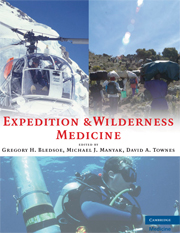Book contents
- Frontmatter
- Contents
- Contributors
- Foreword
- Preface
- Acknowledgments
- PART I EXPEDITION PLANNING
- PART II EXPEDITIONS IN UNIQUE ENVIRONMENTS
- PART III ILLNESS AND INJURIES ON EXPEDITIONS
- 24 General Medical
- 25 The Diarrhea of Travelers
- 26 Malaria: Diagnosis, Prevention, and Treatment for the Traveler
- 27 Wild Animal Attacks and Injuries
- 28 Snake and Arthropod Envenoming
- 29 Hazardous Marine Life
- 30 Expedition Toxicology
- 31 Environmental Injuries
- 32 Penetrating and Explosive Wounds
- 33 Drowning and Submersion Injury
- 34 Evaluation and Acute Resuscitation of the Trauma Patient
- 35 Principles and Practice of Expedition Wound Management
- 36 Expedition Eye Injuries and Disorders
- 37 Dental Medicine on Expedition
- 38 Foot Injuries
- 39 Expedition Orthopedics
- 40 Expedition Self-Rescue and Evacuation
- 41 Aeromedical Evacuations
- APPENDIX The Expedition Medical Kit
- Index
40 - Expedition Self-Rescue and Evacuation
from PART III - ILLNESS AND INJURIES ON EXPEDITIONS
Published online by Cambridge University Press: 05 March 2013
- Frontmatter
- Contents
- Contributors
- Foreword
- Preface
- Acknowledgments
- PART I EXPEDITION PLANNING
- PART II EXPEDITIONS IN UNIQUE ENVIRONMENTS
- PART III ILLNESS AND INJURIES ON EXPEDITIONS
- 24 General Medical
- 25 The Diarrhea of Travelers
- 26 Malaria: Diagnosis, Prevention, and Treatment for the Traveler
- 27 Wild Animal Attacks and Injuries
- 28 Snake and Arthropod Envenoming
- 29 Hazardous Marine Life
- 30 Expedition Toxicology
- 31 Environmental Injuries
- 32 Penetrating and Explosive Wounds
- 33 Drowning and Submersion Injury
- 34 Evaluation and Acute Resuscitation of the Trauma Patient
- 35 Principles and Practice of Expedition Wound Management
- 36 Expedition Eye Injuries and Disorders
- 37 Dental Medicine on Expedition
- 38 Foot Injuries
- 39 Expedition Orthopedics
- 40 Expedition Self-Rescue and Evacuation
- 41 Aeromedical Evacuations
- APPENDIX The Expedition Medical Kit
- Index
Summary
INTRODUCTION
Few expeditions in modern times are prepared to go to the lengths of an earlier era when it comes to self-rescue. With satellite phones, GPS positioning, and modern air transport, it is unlikely that any major expedition to any area on earth, no matter how remote, will ever again be as isolated as famous expeditions of the past. The epic survival stories, such as that of Ernest Shackleton and his stranded Endurance crew in Antarctica, are largely the stuff of history. However, even today, ships still sink with all hands on board, and climbers still are lost and their bodies never recovered.
Expeditions have limited resources for treating threats to life and limb. Prevention of injury and illness is therefore extremely important on expeditions. For example, it is better to ascend slowly to high altitudes than to rush up a mountain and be forced to treat expedition members with high-altitude illness. If proper prevention measures fail, however, then the expedition physician must be prepared to deal with untoward events.
It is in the spirit of preparation for untoward events that this chapter on expedition self-rescue is written. Some of the measures taken in advance will complement self-rescue planning. These include provision of communications gear, such as satellite phones and external rescue plans. Other measures, such as including expedition members with search and rescue experience, selfrescue experience, and medical skills and bringing along rescue and medical equipment may enhance the ability of an expedition to perform a self-rescue and evacuation of ill or injured patients.
- Type
- Chapter
- Information
- Expedition and Wilderness Medicine , pp. 673 - 692Publisher: Cambridge University PressPrint publication year: 2008

